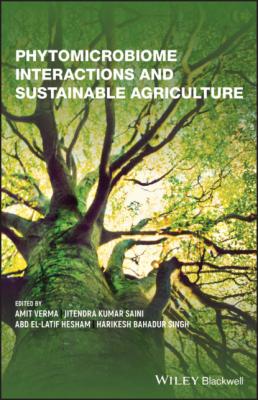Phytomicrobiome Interactions and Sustainable Agriculture. Группа авторов
Читать онлайн.| Название | Phytomicrobiome Interactions and Sustainable Agriculture |
|---|---|
| Автор произведения | Группа авторов |
| Жанр | Биология |
| Серия | |
| Издательство | Биология |
| Год выпуска | 0 |
| isbn | 9781119644828 |
Figure 3.1 Metagenomic approach to reveal the structure and function of a plant microbiome.
(Source: Sleator et al. (2008) © 2008, Society for Applied Microbiology. Reprinted with permissions of John Wiley & Sons).
Table 3.1 Advance molecular techniques used for the characterization of various rhizospheric microbial communities.
| Techniques used | Rhizosphere | References |
|---|---|---|
| Amplicon gene sequencing of conserved marker genes,16S rRNA | Barley and alfalfa | Kumar et al. (2018b) |
| Rice roots | Edwards et al. (2018) | |
| Metagenome sequencing | Taxus rhizosphere | Hao et al. (2018) |
| Wheat and cucumber | Ofaim et al. (2017) | |
| Metatranscriptome sequencing | Wheat | Hayden et al. (2018) |
| Seagrass Microbiomes | Crump et al. (2018) | |
| Metaproteomic profiling | Biscutella laevigata | Mattarozzi et al. (2017) |
| Sugarcane | Lin et al. (2013) | |
| Metabolomic profiling | Arabidopsis | Pétriacq et al. (2017) |
However, metagenomic prediction by quantifying the 16S rRNA gene has revealed an abundance of bacteria in the rhizosphere (Lopes et al. 2016). Bacterial diversity associated with the rhizosphere of wheat plants (Triticum aestivum) was also explored using metagenomic analysis. It revealed the presence of a highly diverse class of bacteria in the wheat rhizosphere, which includes Actinobacteria, Bacilli, Clostridia, Alphaproteobacteria, Betaproteobacteria, Deltaproteobacteria, Gammaproteobacteria, and few uncultivable bacteria (Velázquez‐Sepúlveda et al. 2012). Some of the recent metagenomics techniques used to reveal various rhizospheres are listed in Table 3.1.
3.4 Metagenomics of Plant Phyllosphere
The aerial habitat occupied by microbes is generally termed as the phyllosphere. The estimated colonized microbial area in the terrestrial leaf surface is about 6.4 × 108 km2 (Morris and Kinkel 2002). Rastogi et al. (2010) found that only 0.1–8.4% of the total bacterial population were cultivable. Phyllosphere microbiome was reported for their involvement in nitrogen fixation, biodegradation of pollutants (Waight et al. 2007), and antibodies production and systemic resistance induction in the host plant (Sundaram et al. 2011; Bodenhausen et al. 2014). Several studies have been conducted to reveal the microbiome of the plant leaf surfaces (Finkel et al. 2016). Methe et al. (2017) identified sets of functional gene annotations that differ between drought and well‐watered maize phyllosphere metagenomes from field plots.
The 454‐pyrosequencing platform comprising rRNA or ITS amplicon sequencing, whole‐genome sequencing, shotgun metagenomics, and transcriptional profiling is widely employed for microbial community analysis (Rastogi et al. 2012; Correa‐Galeote et al. 2018). These revolutionary technological innovations facilitate the comparative microbiome analyses and provided a deep insight into the structural and functional characteristics of phyllosphere microbiome. Furthermore, in an interesting study of netaproteogenomic analysis (includes metagenomics and metaproteomics) of rice microbiome revealed that methanol‐based methylotrophy linked to the genus Methylobacterium dominated within the protein repertoire of the phyllosphere microbiota (Knief et al. 2012). Similarly, a combined metagenomic and metaproteomic approaches were also applied for analyzing the physiology of phyllosphere bacterial communities in situ (Delmotte et al. 2009). Several reports in the public domain reveal phyllosphere microbial diversity through metagenomic approaches (Atamna‐Ismaeel et al. 2012; Ritpitakphong et al. 2016; Mukhtar et al. 2017).
3.5 Metagenomics of Plant Endosphere
Microorganisms from the endosphere penetrate and invade into the root internal tissues. A vast array of plants' endosphere is colonized by fungi (Vandenkoornhuyse et al. 2002; Smith and Read 2008), bacteria (Reinhold‐Hurek and Hurek 2011) and, some time by Archaea (Sun et al. 2008). The molecular tools to increase our comprehension about the endophytic lifestyle within the host plant are poorly understood (Reinhold‐Hurek and Hurek 2011). Metagenomic studies might be helpful to lengthen advancement in this enthralling research area. Furthermore, the metagenomics approach can also be helpful to elucidate the potential of uncultivable endophytic microbial communities, thus revealing the information beyond the genomic information of an individual in the endosphere microbiome (Dinsdale et al. 2008). Moreover, metagenomic studies mainly depend upon the quality of metagenomic DNA extracted from environmental samples. Also, the prevalence of genomic DNA from the plant biomass limits the application of bacterial transcriptome sequencing or metagenome (Utturkar et al. 2016). Here, significant biases in the DNA extraction methodology from endophytic communities may be introduced (Kgomotso et al. 2015). In this context, some workers also observed that the recovery of a diverse class of endophytic communities associated with plant tissues could be enabled by using broad‐spectrum SDS‐based DNA extraction protocol (Maropola et al. 2015). Separation of the host's genome from the endophytic microbiome's metagenome is a challenging assignment. Due to this, it is rare to achieve full sequencing of an endophytic microbiome by complex procedures like extensive deep genome sequencing (Campisano et al. 2014). However, reports are available which enlighten the endophytic microbiome up to some extents using metagenomics (Tian et al. 2015; Vandenkoornhuyse et al. 2015; Sengupta et al. 2017). Utilizing metagenomic analysis, Sessitsch et al. (2012) reported the functional characteristics of an endophyte community that colonizes rice roots. Similarly, metagenomics workflow analysis of endophytic bacteria from oil palm fruits has been described by Tanjung and coworkers (Tanjung et al. 2017).
3.6 In‐silico Tools for Metagenome Analysis
Metagenome sequencing generally ends up with the generation of a huge pool of nucleotide sequences. This vast data set of nucleotide sequences need to be analyzed thoroughly before converting it to meaningful information. The in‐silico approaches, which include several bioinformatics tools, have helped metagenome researches in data mining. These tools
